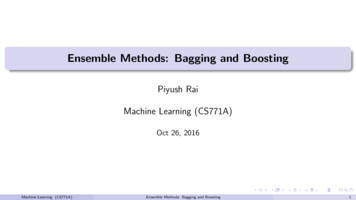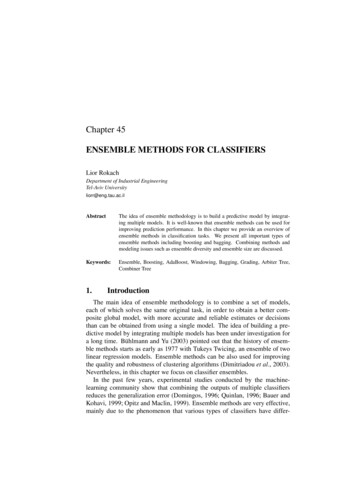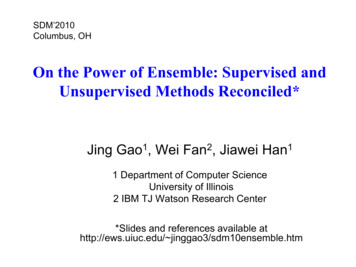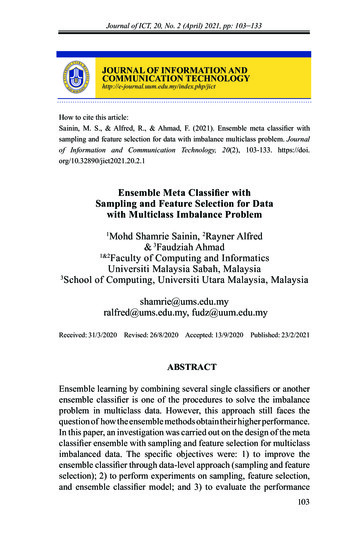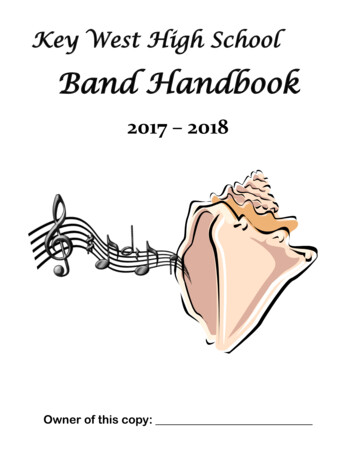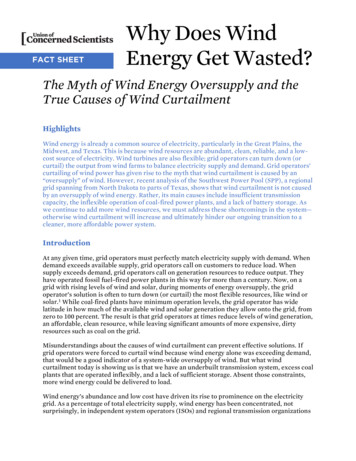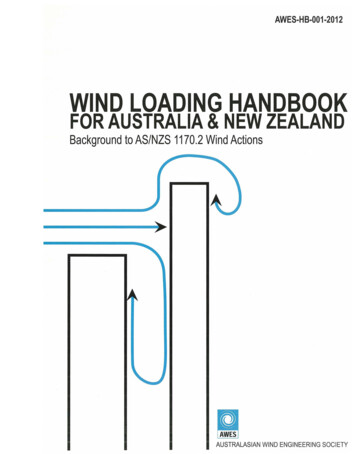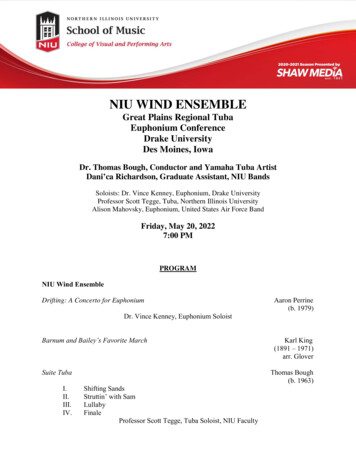
Transcription
presents theirWind Ensemble&Wind SymphonyConductorsWind EnsembleDr. Frank TraczMr. Eric ThompsonMr. Brett ButlerWind EnsembleDr. Alex WimmerMarch 9, 2021 - 7:30 PMMcCain Auditorium
Wind SymponyConductor: Dr. Alex WimmerFinding the Sun (2019) . Grace Baugher (b. 1995)Nimrod (1899/1965).Sir Edward Elgar (1857-1934)Arr. Alfred Reed (1921-2005)Arabesque (2009) . Samuel Hazo (b. 1966)Wind EnsembleConductor: Dr. Frank TraczDancing Fire (2016) . Kevin Day (b. 1996)Eric Thompson, Guest ConductorBeside Still Waters (2011) . David Gillingham (b.1947)Brett Butler, Guest Conductor
2021 Wind Symphony RosterFLUTEJordyn AllenKate BrullSam CrawfordBrenda HeardKristen Schrag Gabby YagerOBOEAlli GladfelderLily LinvilleBASSOONRachel WoodburyCLARINETCorrine BergstromPeri CarneyKrissy Davis Sarah KelleyHaley RaderBASS CLARINETGrace DiceALTO SAXOPHONEKatherine AndersonJulia McCabe TENOR SAXOPHONEJasmine BatesBARITONE SAXOPHONEAbby Vetter Principal Section PlayerTrumpetAnn BarkerAaron PetersonMichele TreloggenKate Washburn French HornGus Bibler Alex CannadyCara DisterIsabel GrafelTromboneAlianna CarltonBlake DavisChris Hovis EUPHONIUMShelly AlexanderMichael Walker TubaRobert BrownJoey LederhosPERCUSSIONGaby FlukeEthan JeffriesNathan Smith Jacob MorganIsaiah PetrieChristopher WellsPIANOKevin Jackson
2021 Wind Ensemble RosterFLUTEJenna DominguezNicole HoppasJessica Minnich Amaya MolinarBailey TaddaRylie ToomTRUMPETMitchell BetancourtGillian FalconKyle GrimesCaleb NiehoffHaley Schwartz Jessica VanstoryOBOETaylor CrawfordDeandra Horner FRENCH HORNKylee GardnerKatie KimmelElliot PetersSophia Shaar BASSOONJosh BrandtCLARINETMark AhlmanTaton BennettAudrey FarrellMatthew Johnson Crystal RathburnBASS CLARINETMegan PaulsenALTO SAXOPHONEHannah ManciniJacob PetersonNosara Vargas TENOR SAXOPHONESarah WolfeBARITONE SAXOPHONEJames Probst Principal Section PlayerTROMBONEJakob Keith Tyler LongWilliam OsorioDaniel SmithEUPHONIUMJakob FerreriaJustin Koegeboehn TUBAClark Elford PERCUSSIONBraedon BomgardnerBrett Butler Taylor ClarkThomas DenkJohn EldridgeBrandon WellsPIANOThomas Denk
Wind SymphonyP r og r am No t e sFinding the SunGrace Baugher (b. 1995)Finding the Sun is made up of 3 pieces written as an exploration of the band grading systems.This experiment highlighted irregularities within the systems and proved that they are notreliable as a consistent resource for composers. In this experiment, I wrote the same pieceat 3 grade levels adhering to the set systems available, drawing on my own experiences as acomposer and performer, and researching other composers who had altered pieces to variousskill levels. The three versions of Finding the Sun were the result.On a more personal note, the piece itself was a documentation of my experience writing thepieces for my thesis project. This programmatic music cycles through the peaks and valleys ofthe process and depicts moments of self-doubt and celebration. When I began the process ofwriting, the piece was called “Up into the Night.” This darker imagery eventually didn’t matchthe direction of the piece. A line from “May it Be” by Enya from The Lord of the Rings sums upmy experience and vision for the piece perfectly: “When the night is overcome, you may riseto find the sun.” Finding the Sun reminds me that life is a process and that even when the baddays seem too much, the sun with always rise the next day.Grace Baugher is a Kansas-born composer whose music employs memorable melodic materialand whimsical styles. She is a graduate of the University of Tennessee in Knoxville with aMasters in Music Composition and Graduate Certificate in Music Theory Pedagogy. Previouslyshe studied at Kansas State University where she had pieces performed by many ensembles,faculty, and guest artists. Considered one of the rising young voices in wind band, her musichas been performed across the United States at a variety of conferences and schools, and nowaround the globe. Most recently, her piece “Remembering the Remarkable” was selected as a top100 piece for wind band in 2020 by Bandworld. She is currently finishing a Graduate Certificatein Music Education to become certified to teach and work with bands beyond her compositions.Program notes by Grace BaugherNimrodSir Edward Elgar (1857-1934) - Arr. Alfred Reed (1921-2005)The Enigma Variations were written for orchestra in 1899 and bore the dedication “To MyFriends Pictured Within.” The theme and fourteen variations catapulted Elgar to internationalacclaim. The story is told of how Elgar, returning home after a long day of giving violin lessons,sat down to unwind at the piano and tinkered by improvising. His wife commented on oneof the melodies that emerged, and out of that exchange was born the concept of fashioningthe original melody . as it might be played by some of their friends in their own style. In all,fourteen people and a dog are featured in the Variations.Elgar was the dominant English composer of his time, and was knighted in 1904, awarded theOrder of Merit in 1911, and made Master of the King’s Musick in 1924.Elgar wrote the Enigma Variations in 1899 and dedicated them “to my friends pictured within.”The theme and 14 variations belong to the period in which Elgar developed the style that placedhim in the front rank of English composers. The beautifully lyrical Nimrod (Variation IX) isdedicated to the publisher A.J. Jaeger. (Nimrod is the great hunter of the bible; Jaeger is theGerman word for hunter.)
Alfred Reed was born on Manhattan Island in New York City on January 25, 1921. His formalmusic training began at the age of 10, when he studied the trumpet. As a teenager, he playedwith small hotel combos in the Catskill Mountains. His interests shifted from performing toarranging and composition. In 1938, he started working in the Radio Workshop in New York asa staff composer/arranger and assistant conductor. With the onset of World War II, he enlistedand was assigned to the 529th Army Air Corps Band. During his three and a half years ofservice, he produced nearly 100 compositions and arrangements for band. His most notablecomposition was Russian Christmas Music, premiered in Denver on December 12th, 1944, whichmany say launched his career as a composer. After his discharge, Reed enrolled at the JuilliardSchool of Music and studied composition with Vittorio Giannini. In 1953, he enrolled at BaylorUniversity, serving as conductor of the Symphony Orchestra while he earned the Bachelorof Music degree (1955) and his Master of Music degree (1956). His interest in the developmentof educational music led him to serve as executive editor of Hansen Publishing from 1955 to1966. He left that position to become a professor of music at the University of Miami, wherehe served until his retirement in 1993. After retirement, he continued to compose and madenumerous appearances as guest conductor in many nations, most notably in Japan with theTokyo Kosei Wind Orchestra. At the age of 84, on September 17, 2005, Alfred Reed passed away.Program notes from Nikk Pilato and Alex WimmerArabesqueSamuel Hazo (b. 1966)Arabesque was commissioned by the Indiana Bandmasters Association and written for the 2008Indiana All-State Band. Arabesque (2009) is based in the mystical sounds of Middle Easternmusic and it is composed in three parts. “Taqasim” (tah’-zeem), “dabka” (dupp-keh) and“chorale.”“Both sets of my grandparents immigrated to the United States; my mother’s parents wereLebanese, my father’s mother was Lebanese and his father was Assyrian. Sometimes incomposition, the song comes from the heart, sometimes from the mind, and sometimes (asin this case) it’s in your blood. The Indiana Bandmasters Association asked for a piece thatwas unique. I had not heard any full-out Arabic pieces for wind orchestra, and I knew ofthis culture’s deep and rich musical properties so I figured that one might as well comefrom me. (Plus, my mom asked if I was ever going to write one.)” Sam HazoSamuel R. Hazo resides in Pittsburgh, Pennsylvania with his wife and children. Mr. Hazo remainsthe only winner of both composition contests sponsored by the National Band Association. Hehas composed for the professional, university and public-school levels in addition to writingoriginal scores for television, radio and the stage. Mr. Hazo was asked by the Newtown SchoolDistrict to compose the memorial for the children and women who were lost in the tragedyat their Sandy Hook Elementary School. The result was a major work for Choir, Orchestraand Wind Band combined titled “Glorificare.” Mr. Hazo also composed “Bridges,” which hewas requested to write by Virginia Tech University following their tragic shootings. In 2012,two of Mr. Hazo’s compositions were performed at the London Summer Olympic Games. Hiscompositions have been performed and recorded world-wide. Additionally, numerous titles ofMr. Hazo’s works are included in the series “Teaching Music Through Performance in Band.” Hehas served as composer-in-residence at Craig Kirchhoff ’s University of Minnesota ConductingSymposium and has also lectured on music and music education at universities and highschools internationally. Mr. Hazo was twice named “Teacher of Distinction” by the southwesternPennsylvania Teachers’ Excellence Foundation.Program Notes by Samuel Hazo
Wind EnsembleP r og r am No t e sDancing FireKevin Day (b. 1996)When I was writing Dancing Fire, I wanted to write a piece for my high school band programand its directors for the great pieces we played, the fun times we had, and the excitement ourbands created at our concerts. The picture I had in my head before I began writing was a groupof people surrounding a large bonfire during the night. These people began dancing around thefire, having fun, singing songs, and ultimately, celebrating life.Once I had that picture in my head, along with the constant repeating motif that eventuallybecame the melody for the entire piece, the rest of the work fit together nicely, and in twoweeks it was done. The composition brings this mental picture I had to life in a fun andenergetic way with dance-like percussion and a constant groove, as well as its contagiousmelody, a mysterious soprano sax solo, and a climactic ending.This was written in dedication to the Arlington High School Band Program in Arlington, Texas,and to my former band directors, Michael Hejny, Nathan Burum, and Nathan Hervey.Program notes by Kevin DayBeside Still WatersDavid Gillingham (b.1947)In 1862, Newton Theological student, Joseph H. Gilmore, wrote the words to the hymn, HeLeadeth Me, having been inspired by one of his own sermons on the 23rd Psalm. The words,“He leadeth me” from the Psalm took on new meaning for Gilmore and in a matter of minutes,he had penciled out the words to this new hymn. It was later set to music by William B.Bradbury. The title of this work is inspired by the third line of Psalm 23, “He leads me besidestill waters”. Beside Still Waters is a “chorale fantasy” on the Bradbury tune and seeks tohighlight both the peaceful and dramatic message of the words.Program notes by Dr. David R. Gillingham,
Wind Symphony ConductorDR. ALEX WIMMER is currently serving as the Assistant Director of Bands at Kansas State University. His duties include directing the Wind Symphony, Cat Band(basketball pep band), Volleyball Band, Pub Crawl Band, Assistant Marching BandDirector for the Pride of Wildcat Land (KSUMB), arranger and drill designer for theKSUMB, and instructor of undergraduate and graduate courses in conducting, arranging, and marching band techniques. Prior to his appointment at Kansas StateUniversity, Dr. Wimmer was a Graduate Teaching Assistant for the Kansas StateUniversity Bands. He assisted with all concert and athletic ensembles, undergraduate conducting courses, and Percussion Ensembles. His research interests includeundergraduates conducting with expressivity and qualitative research.Originally from Gretna, Nebraska, Dr. Wimmer received his Bachelor of Musicdegree from the University of Nebraska at Omaha in 2007, his Master of Musicdegree in Education with an emphasis in Wind Conducting from Kansas StateUniversity in 2014, and his Doctorate in Philosophy in Curriculum and Instructionfrom Kansas State University in 2017. Dr. Wimmer was the Director of Bands atGretna High School and the Assistant Director of Bands at Gretna Middle Schoolfrom 2007-2012. Under his direction his concert, jazz, and marching bandsreceived consistent superior ratings. He was a recipient of the Jack R. SniderYoung Band Director Award in 2011 and served on the Nebraska Music EducatorsAssociation Leadership Academy from 2011-2012.Dr. Wimmer is in demand as a conductor, clinician, and adjudicator as well asa percussion specialist. His professional affiliations include the Kansas MusicEducators Association, the Kansas Bandmasters Association, the National Association for Music Education, the College Band Directors National Association, thePercussive Arts Society, Kappa Kappa Psi, Phi Mu Alpha Sinfonia, and Phi KappaLambda.Dr. Wimmer is married to his wife Anna and has two daughters: Addison andAnora.
Wind Ensemble ConductorDR. FRANK TRACZ is Professor of Music and Director of Bands at Kansas StateUniversity. He earned his B.M.E. from The Ohio State University, the M.M. fromthe University of Wisconsin, Madison, and Ph. D. from The Ohio State University. He has public school teaching experience in Wisconsin and Ohio and hasalso served as Assistant Director of bands at Syracuse University and Directorof bands at Morehead State University. Dr. Tracz has served as an adjudicator,clinician, speaker in various schools and conferences and has conducted All-Stateand Honor bands across the United States as well as in Canada, Singapore, SouthAfrica, Fiji, Australia, and New Zealand.At Kansas State he directs the Wind Ensemble and the Marching Band, teachesgraduate and undergraduate conducting, advisor to Kappa Kappa Psi, Tau BetaSigma, and the Band Ambassadors, and administers and guides all aspects ofa large BIG XII comprehensive band program. Ensembles under his directionhave been invited to perform at numerous State conferences, MENC, two CBDNAregional conferences, The Larry Sutherland Wind band Festival at Fresno State,Carnegie Hall, and the Kennedy Center. The marching band was awarded theprestigious Sudler Trophy in 2015. The Wind Ensemble has been invited to perform at the International Convention of the American Bandmasters Associationin 2019 in Loveland, CODr. Tracz is on the faculty of the Conn-Selmer Institute, adjunct faculty of theAmerican Band College, past member of the Music Education Journal EditorialBoard, contributor to the Teaching Music Through Performance In Band series,and was recently appointed Chair of the Sudler Trophy Project of the JohnPhilip Sousa Foundation. His honors include the Stamey Award for outstandingteaching, Kansas Bandmasters Outstanding Director award, Wildcat Pride AlumniAssociation award, the Tau Beta Sigma Paula Crider Outstanding Band Directoraward, named a Lowell Mason fellow, and Phi Kappa Phi Honorary Fraternity.He has also received the Conn-Selmer Institute Hall of Fame award, the KansasState Professorial Performance award, and was elected to the prestigious American Bandmasters Association.Dr. Tracz is married to Geralyn, and has three daughters, Jessica Tracz Kelly, KelleyTracz, and Carly Tracz.
Guest ConductorsBRETT BUTLER is originally from Lenexa, KS. He graduated from Kansas StateUniversity in 2017 with a B.M. in Music Education. During his time at Kansas State,he was involved with the Pride of Wildcat Land as an assistant and head section leader of the snare line. Also at K-State, Brett played in the Wind Ensemble,Brass Ensemble, Woodwind Ensemble, Cat Band, Pub Crawl Band and PercussionEnsemble.Brett is a member of the Percussive Arts Society and Phi Mu Alpha Sinfonia. Aftergraduating at K-State, Brett has served as an Assistant Band Director in Louisburg,KS. Brett has been teaching in Louisburg, KS for two years. He assists the HeadBand Director, John Cisetti with the high school, middle school and elementarybands. Brett has had the opportunity to march in the 129th Annual Rose Paradewith the Louisburg Wildcat High School Marching Band in 2018. Brett instructsthe high school drumline, jazz band and substitutes in the Louisburg 416 District.Brett has also taught at R.E.W. Music as a private percussion studio instructorsince the Summer of 2018. Brett is a member of the Kansas City Wind Symphony as a percussionist since the Fall of 2018. Brett has been an active percussionistin the Shawnee Mission Theatre in the Park musicals and for the Leawood StageCompany. Brett also has performed with Topeka Symphony Orchestra as a percussionist since 2016. Brett has assisted with Leadership and Auxiliary camps forK-State in the summer of 2017 instructing drumlines with the percussion GTA.ERIC THOMPSON received his Bachelors in Music Education from the Universityof Georgia. While at UGA, Eric performed as principal trumpet of the Wind Symphony and Symphonic Band, trumpet soloist with the Redcoat Marching Band,and as a featured trumpet soloist at Midfest. Additionally, he traveled abroadto China for a 15-day performance tour and studied under the world-renownedtrumpet player, Fred Mills.Eric has nine years of teaching experience in the Georgia Public Schools, specifically at Treutlen High School and, most recently, at Mary Persons High School.Bands under his direction have experienced a dramatic increase in enrollment,and have consistently received superior evaluations and best in class awards.Eric is an active member of the Georgia Music Educators Association (GMEA),National Band Association (NBA), International Trumpet Guild, and Phi Mu Alpha,the men’s national music fraternity. Eric married his best friend Dory in June of2018, and they are both excited about moving their new family to become a partof the Kansas State family.
As the first land-grant institution established under the 1862 Morrill Act, weacknowledge that the state of Kansas is historically home to many Nativenations, including the Kaw, Osage, and Pawnee, among others. Furthermore,Kansas is the current home to four federally recognized Native nations: ThePrairie Band Potawatomie, the Kickapoo Tribe of Kansas, the Iowa Tribeof Kansas and Nebraska, and Sac and Fox Nation of Missouri in Kansasand Nebraska. Many Native nations utilized the western plains of Kansasas their hunting grounds, and others – such as the Delaware – were movedthrough this region during Indian removal efforts to make way for Whitesettlers. It’s important to acknowledge this, since the land that serves as thefoundation for this institution was, and still is, stolen land. We rememberthese truths because K-State’s status as a land-grant institution is a story thatexists within ongoing settler-colonialism, and rests on the dispossessionof Indigenous peoples and nations from their lands. These truths are ofteninvisible to many. The recognition that K-State’s history begins and continuesthrough Indigenous contexts is essential.www.k-state.edu/band@kstatebands
University, Dr. Wimmer was a Graduate Teaching Assistant for the Kansas State University Bands. He assisted with all concert and athletic ensembles, undergrad-uate conducting courses, and Percussion Ensembles. His research interests include undergraduates conducting with expressivity and qualitative research.

